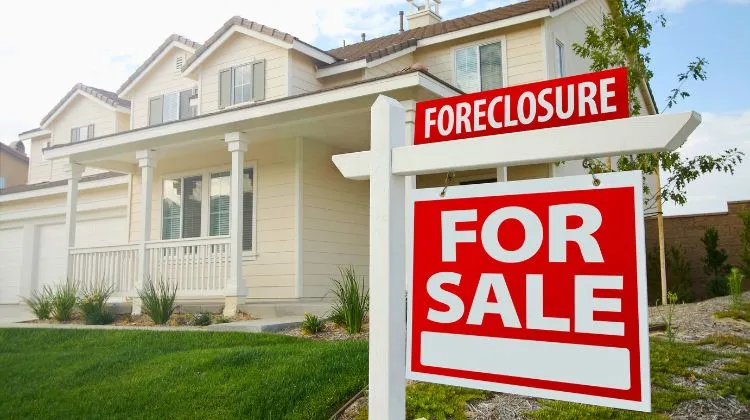The feeling is heavy. It’s that pit in your stomach when you look at a pile of bills and know you’re behind. When you’ve served your country, the fear of losing your home feels like an unimaginable betrayal. For thousands of veterans, this fear has been a daily reality, but you should know that real veterans foreclosure help is finally here.
You’ve likely been on a frustrating journey, with programs appearing and disappearing, leaving you in the dark. It’s confusing and feels incredibly unfair. You need clear answers and a path forward, and that’s exactly what you’ll find here, including information on brand new veterans foreclosure help.
Table of Contents:
- A Rollercoaster of VA Mortgage Programs
- A Bipartisan Rescue: What the New Law Means for You
- Finding Veterans Foreclosure Help: Your Action Plan
- Step 4: Understand All Your Options
- Why Old Solutions Stopped Working
- Conclusion
A Rollercoaster of VA Mortgage Programs
If you’re feeling whiplash from the Department of Veterans Affairs, you’re not alone. The past few years have been a chaotic ride for veteran homeowners seeking help. It’s important to understand this backstory because it validates the frustration you are likely feeling.
For a long time, there were solid programs in place to assist veterans. But in 2022, the VA quietly ended a popular option that let veterans move missed payments to the back of their loans. This program was a lifeline for many experiencing financial hardships, but it vanished without a clear replacement.
After an investigation by NPR brought the issue to light, the Veterans Affairs scrambled to act. They temporarily paused foreclosures and launched a new rescue plan called the VA Servicing Purchase (VASP) program. VASP was a purchase program where the VA would buy your delinquent VA loan from the mortgage servicer and give you a new, affordable one, and it helped thousands stay in their homes.
Why the Help Disappeared (Again)
Just as veterans started to get relief, the VASP program was suddenly canceled. Political concerns over the long term cost of VASP led the VA to end it on May 1st, 2025. This left tens of thousands of veterans facing financial hardships without a viable safety net program once more.
This decision was crushing for veterans having difficulty making mortgage payments. The other options, like a standard loan modification, were often unaffordable for a VA mortgage. With mortgage rates hovering high, a modification could sharply increase your monthly mortgage payment, pushing you closer to foreclosure instead of saving you from it.
Since that day, mortgage companies have been telling many veterans they have only two choices. They could either sell their homes or face foreclosure proceedings. That’s a terrible position to be in after serving our nation, with many at risk of joining the ranks of homeless veterans.
A Bipartisan Rescue: What the New Law Means for You
After all that back and forth, there is finally good news. Congress stepped in with a rare display of bipartisan unity. Democrats and Republicans, including Senators Jerry Moran and Richard Blumenthal, came together to pass a new law to fix this problem for good.
The VA Home Loan Program Reform Act creates a permanent solution for veterans facing foreclosure. The bill, also championed in the House by Representatives Mike Bost and Mark Takano, is built on a simple, proven idea that should have always been available. The Senate passed the legislation to give the VA a dependable tool to help veterans stay in their homes.
This isn’t just another temporary patch; this program reform is a stable, long term solution that restores a critical safety net. The lawmakers behind the bill acknowledged the VA loan program is one of the most significant benefits VA offers. This reform strengthens its ability to help families build wealth and secure their housing.
How the New Program Works
So what does this new law actually do for you? It directs the VA to create a new partial claim program, similar to options other homeowners with Federal Housing Administration (FHA) or USDA loans have had for years. This foreclosure prevention tool is straightforward and effective.
Instead of facing a massive bill for missed payments, this assistance program takes that amount and sets it aside as a junior lien. Your mortgage becomes current again, so you can resume making your regular monthly payments. You are no longer considered delinquent by your loan servicer.
The amount set aside is still owed, but it’s moved to the back of your loan term. You’ll pay it off down the road when you sell the home, refinance your mortgage, or pay the loan off completely. This gives you breathing room now when you need it most, helping prevent foreclosure.
Finding Veterans Foreclosure Help: Your Action Plan
Knowing that help exists is one thing. Getting it is another. You need to take specific steps to use this new program. Don’t wait for your lender to reach out to you.
Being proactive is your best strategy for your VA loan foreclosure. The system can be slow, but your actions can speed things up. Here is a simple plan to follow.
Step 1: Contact Your Mortgage Servicer
Your very first call should be to your mortgage servicer. This is the company you send your monthly payments to. Their phone number and contact information are on your mortgage statement.
Tell them you are a veteran with a VA loan and are having trouble making mortgage payments. Be clear that you want to keep your home. Ask them about your options for mortgage relief to avoid foreclosure.
You need to be persistent, as the news of this program is still fresh. It is possible the customer service agent you speak with might not be aware of the newest changes yet. This is why the next step is so important.
Step 2: Mention the New VA Partial Claim Program
When you speak to your servicer, you should specifically mention the new partial claim program created by the VA Home Loan Program Reform Act. Some mortgage servicers might call it a loan deferment option. Using these keywords can help the agent find the right department.
Explain that you understand this loan program can bring your loan current. It lets you resume your regular payments. Ask them to start the application process for you.
If they seem unsure, ask to speak with a loss mitigation specialist or someone in their department that handles VA loans. These employees are more likely to have the most up to date information from the Veterans Affairs. Be polite but firm in your request to explore this option.
Step 3: Work with a VA Loan Technician
You don’t have to go through this alone. The VA has loan technicians who are experts in these situations. Their job is to help veterans and servicers find solutions.
You can get free help from a VA loan technician who can provide va support. They can talk with your servicer on your behalf. They can make sure you’re being offered all the help you are entitled to under the law.
You can find more information and ask for help by visiting the official VA housing assistance website. They give you the direct number to call to speak with one of these specialists. It’s a free service from the Department of Veterans Affairs, so you should absolutely use it.
Step 4: Understand All Your Options
The new partial claim program is the best option for most, but it’s good to know the other possibilities. Your servicer should review all potential solutions with you. These could include the following.
- Forbearance: This is a temporary pause or reduction of your payments. It can give you short term relief to get back on your feet, but you will have to repay the missed amounts later. This is often a first step when you start having difficulty making payments.
- Loan Modification: A modification permanently changes the terms of your loan. It might lower your interest rate or extend the loan term to make your monthly payment more affordable. But, this can be difficult in a high interest rate environment.
- Selling Your Home: Sometimes, selling your home may be the only choice. A regular sale is much better for your credit and financial future than a loan foreclosure. The VA can provide guidance to assist veterans in this process too.
Here is a simple table to compare these options:
| Option | How It Works | Best For |
|---|---|---|
| Partial Claim | Missed payments are moved to the end of the loan. You resume normal payments immediately. | Veterans who can afford their original payment but fell behind. |
| Forbearance | Payments are paused or reduced for a short, specific period. | Veterans experiencing a temporary financial setback. |
| Loan Modification | Loan terms (rate, length) are permanently changed to lower payments. | Veterans who need a permanently lower monthly payment. |
| Home Sale | You sell the property to pay off the mortgage debt. | Veterans whose financial situation has changed permanently. |
Why Old Solutions Stopped Working
You might wonder how things got so bad in the first place for VA loans. The VA Home Loan program has been a cornerstone of veteran benefits since 1944, helping former service members from the Air Force and all other branches. It is usually incredibly stable and successful.
The problem was a perfect storm of events. First, the COVID-19 pandemic caused widespread financial hardship. Federal programs let homeowners, including veterans, pause their mortgage payments for a time through forbearance.
But when those forbearance periods ended, interest rates had shot up dramatically. The old way to fix a delinquency, a loan modification, suddenly became unaffordable for many. Modifying a loan with a 3% interest rate to one at 7% would cause a huge jump in the monthly payment.
This left a huge gap where veterans had fewer protections than almost any other homeowner. At one point, thousands of veterans and active duty troops were delinquent on their VA mortgage loans. The system failed them, and this new law is the government’s attempt to finally fix the loan program reform issue.
Housing advocates, veterans organizations like the American Legion, and the Mortgage Bankers Association have been fighting for this change. The bankers association, in particular, stressed the need for a workable solution for servicers and homeowners. They argued that veterans deserved the same common sense solutions available to others who were facing financial hardships.
Conclusion
The past few years have been uncertain and scary for veteran homeowners facing financial trouble. The chaos surrounding the Veterans Affairs Servicing Purchase, or VASP, program is ending. With the passage of the VA Home Loan Program Reform Act, there is now a clear, stable path forward.
This new program offers real hope and a viable safety net program that has been missing. It provides a way to get back on track without losing your home or facing an unaffordable new payment. The most important thing you can do right now is act quickly and ask for the veterans foreclosure help you have earned.
Don’t delay. Call your mortgage servicer and the Department of Veterans Affairs today. Explain your situation, mention the new partial claim assistance program, and start the process of securing your home for yourself and your family.




Leave a Reply